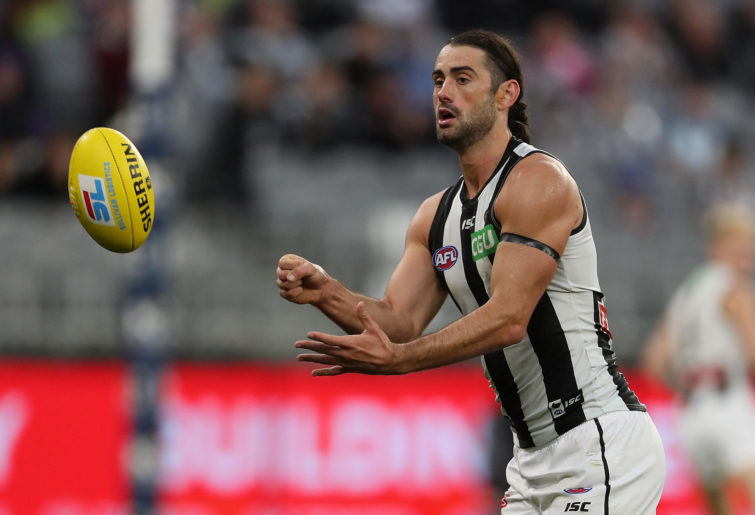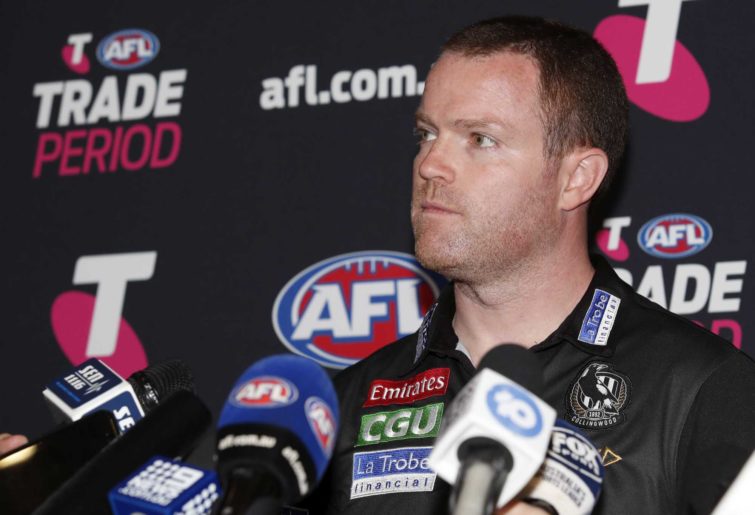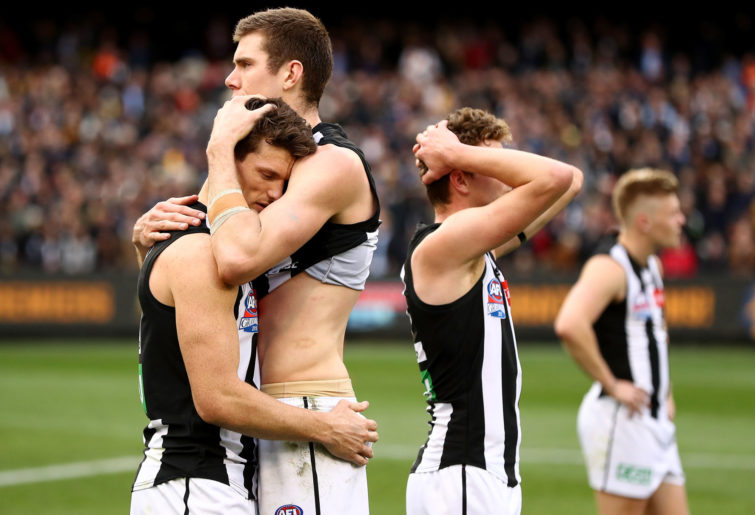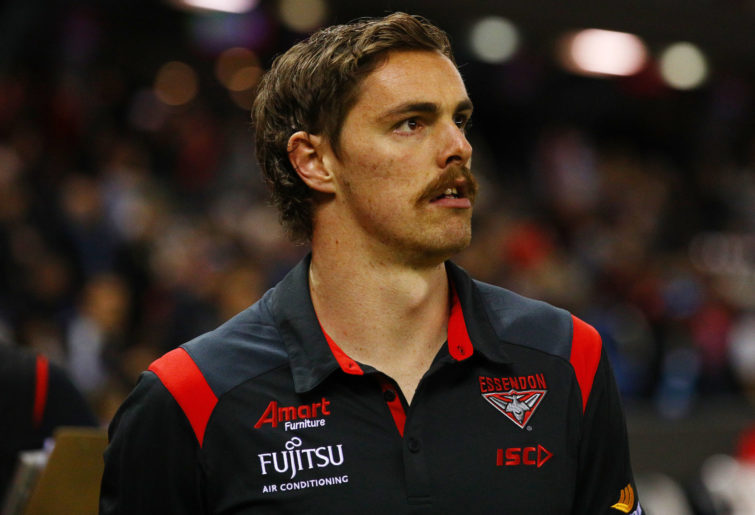All is well in Collingwood land!
We have come away from the draft with a promising crop of youngsters, and some of the points needed to land Nick Daicos – a potential number one – next year.
What an amazing achievement!
It’s also an amazing rationalisation.
Let’s deal with some facts.
We don’t know how good this crop of players will be, or how they’ll contribute to Collingwood’s aspirations. Every club believes they’re coming away from the draft with the right players to build their future. That’s why the clubs select them.
But the future is fragile.
Just three years ago, Collingwood came away from the draft with Jaidyn Stephenson (pick six) and Nathan Murphy (pick 39, but who Collingwood apparently rated as highly as six).
Stephenson’s now gone, and Murphy has played two games. Murphy still has time to build a career at Collingwood, but I’m sure the club would’ve expected him further along, and for Stephenson to be entrenched within the side.
In the 2013 draft, Collingwood netted Matthew Scharenberg (pick six), Nathan Freeman (pick ten), Tom Langdon (pick 65), Jonathon Marsh (pick 77), Sam Dwyer (pick 87), Adam Oxley (pick 92), and Corey Gault (the rookie draft).
You’d think some of these players would be in their prime now. Nope. For one reason or another, they’re all gone.
Now this is not to point at the draft and suggest it’s a wasteland for Collingwood. Collingwood’s had successes (such as Jordan de Goey, Darcy Moore, Brayden Maynard and Brodie Grundy), but this just emphasises the point: we’re dealing in futures, and you never know how they’re going to turn out.

(Photo by Paul Kane/Getty Images)
Six new players are great. But we don’t know what happens from here, so the acquisitions – as well as the strategy to go back to the draft to replenish the list – should be kept in perspective. We genuinely won’t be able to get a gauge on these players, and this strategy, for at least another year, but as many as five.
What shouldn’t be happening is supporters using the draft to forgive the club for the disastrous trade period, or re-envisioning the trade period as part of some master plan that was spectacularly realised on draft night.
It wasn’t.
In trading, the club tried to acquire top ten picks (for the second year in a row), and didn’t have the ability to do it.
They then had to jettison players at below market value just so they could get in a position to move forward into 2021.
You can only assume that there would’ve been salary cap breaches had they not done this, although we can’t be sure because the club is always selling a different message. This should be a bigger issue than it has been – what the club is telling its members, why the message changes, and if it can be believed.
Some supporters don’t care. They blindly follow. Side by side and all that. They’ll claim Collingwood’s purge was a response to the AFL cutting list sizes and the salary cap. Here’s why Collingwood chopped! Why can nobody else see it?

Collingwood list manager Ned Guy. (Photo by Dylan Burns/AFL Photos via Getty Images)
Because it’s a false assumption.
If the AFL’s changes forced Collingwood into action, Collingwood must be prescient because they made their changes before the AFL announced their cuts.
And if the AFL’s cuts were so drastic they forced Collingwood’s hand, surely they would’ve forced other clubs into action to redress their contract management and inflating salary caps. But Collingwood was the only one. That should tell you something in itself.
The AFL has glibly recommended that clubs back-end to deal with the cuts, with one anonymous list manager bemoaning to The Age that the league would “have 18 Collingwoods” on their hands. That shows exactly the danger that every other club fears, and which Collingwood obliviously created, and merrily waltzed into.
Collingwood’s not the rule here. They’re the exception.
Also, last year, Collingwood traded out James Aish and shopped around Matthew Scharenberg to try alleviate salary cap pressure, so (again) this was an issue before any AFL restructuring (to the salary cap and list sizes) took place.
Another fantasy of Tolkien-esque proportions that has emerged is that supporters are happy with the club’s back-ending of contracts since it gave them a shot at a flag. The counter is would attitudes be different had they actually won one?
Okay. Let’s ground ourselves back in reality: Collingwood didn’t win a flag.
That’s the beginning and the end of that discussion.
If I’m going to throw around hypotheticals to make myself feel better about cavalier contract management, I could say, “Would I feel differently if Collingwood four-peated?” Extraordinarily, exaggeratedly dumb, I know, but every bit as valid as any other fantasy because it’s just that: a fantasy.
Nothing more.

(Photo by Ryan Pierse/AFL Media/Getty Images)
Even if people point out that Collingwood got within five points (or 90 seconds) of a flag, it doesn’t change the reality that they didn’t win that flag. A close result might be promising if it was a springboard for something better, but it wasn’t.
It was actually the peak of this list’s accomplishments – after missing the finals four years in a row, it was their first genuine shot at a premiership. And that’s it. One year later, they lost a preliminary final. And throughout 2020, they dwindled, and now they’re soft resetting.
Critics point to Collingwood’s trade period as a fire sale. That’s underselling it. It was more like a nuke – spectacularly destructive and disastrous, with most (even non-Collingwood people) just looking on in stupefied horror, and asking what happened. You have to wonder if there’s an Oppenheimer among Collingwood’s administration who laments what they did, and what became of it.
Probably not.
No other club in a period of contention has shed players as Collingwood did below market value. This is proven. We just have to look at history to see that this hasn’t happened before with any other club.
Richmond’s lost players, but that’s coming following flag after flag after flag. Their exits have also been staggered. Hawthorn cut Luke Hodge, Sam Mitchell, and Jordan Lewis loose, but that was after a three-peat, with these three players at the end of their careers.
Is anybody seriously comparing Collingwood’s journey to those clubs? Because they’re incomparable, unless the evaluator determines losing one grand final is the equivalent of winning three, and getting rid of three young players in or approaching their prime is the same as getting rid of three old players in the twilight of their careers.
Somebody threw up Essendon as a comparison, but the Bombers lost players they wanted to keep. The players happily and freely pursued opportunities elsewhere. Essendon already had pick nine, but also netted pick eight for Adam Saad, and were compensated with pick seven for Joe Daniher.

(Photo by Graham Denholm/Getty Images)
Again, it’s incomparable: a club that wanted to keep three players (Saad, Daniher and Orazio Fantasia) who left, versus a club who drove out three players (Adam Treloar, Jaidyn Stephenson and Tom Phillips) who wanted to stay.
This begs the biggest question of them all: if other clubs can open a window of contention, keep together their playing list, and efficiently manage their salary cap, why couldn’t Collingwood?
And the answer isn’t the party line that they back-ended to keep the list together to give themselves a shot at a flag. That’s the propaganda that people are buying because it’s an easy rationale that allows them to accept the practice and continue to have faith in the club.
The answer’s much simpler: they bungled how they structured their contracts, then had to take drastic, unprecedented action. Are they clear now? We don’t know. Potentially, they might’ve got clear, but now with the AFL’s cuts are tight again.
A reminder of the ineptitude for the next five years will be the $1 million they’ll be paying of Adam Treloar’s salary while he plays for the Bulldogs. We still have no transparency on whether they’ll also be paying anything to Dayne Beams, Jaidyn Stephenson and Tom Phillips.
Certainly, no supporter should be happy with the club paying players to play against them.
Now this isn’t intended to go over old ground as a means of besmirching draft night. Collingwood’s draft night was fantastic and it is laudable. It might be the springboard to a new era.
But, looking at it coldly, practically and removing emotion from it – removing the optics – you have to question how much of Collingwood’s frenetic activity was politically motivated as a means to mollify collective supporter disgruntlement.

(Photo by Ryan Pierse/Getty Images)
“Hey!” the club can exult. “Just look at what we did!”
And, forgetting the trade period, we look at the activity, we look at the players, and we feel all warm and happy inside.
“Yes,” we think reflexively. “The club certainly did a bang-up job.”
We even forgive them – at the very least a little – for the trade period debacle.
But draft night also comes with caveats.
They also traded away next year’s first rounder. This doesn’t get enough of a mention. Collingwood didn’t accomplish what they did on draft night with just 2020’s limited arsenal. They also had to give away their best 2021 pick – but this has regularly been Collingwood’s way, overdrawing on their future to address the present.
The counter will be we just need points to acquire Nick Daicos. Silly me. I would’ve thought having a first rounder and getting Nick Daicos would’ve been the objective – get as much young talent as you can into the club if the plan is to replenish the list.
As it is (and depending on finishes) Collingwood might’ve traded out more points than they’ve brought in, and to get Daicos will likely have to dip into 2022’s booty, like a hopeless gambler constantly dipping into savings, hoping for that big return that’ll settle all debts and leave themselves with a nice little win.
So, hey, great work on draft night making the best of a weak hand.
But all this doesn’t change the fact that it was a weak hand, and even if they made the best of it – even if they’ve exceeded expectations – that hand could’ve (and should’ve) still been much, much stronger if they’d played their cards right from the beginning
They didn’t.
And that should neither be forgotten nor mitigated.

































































































